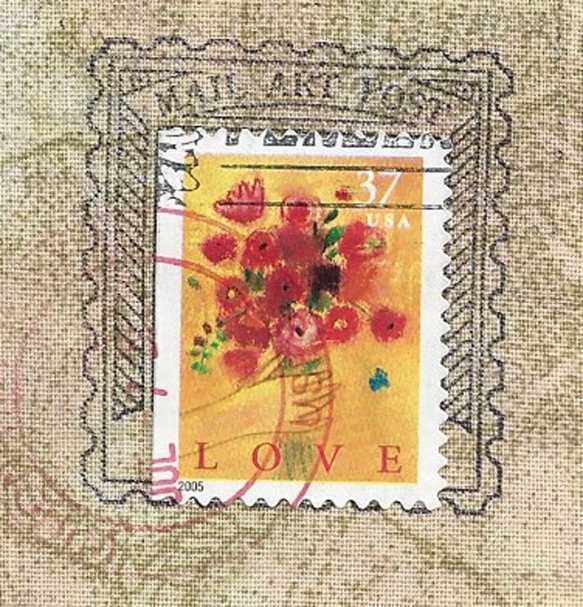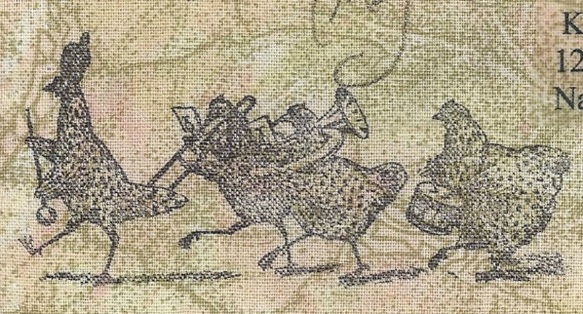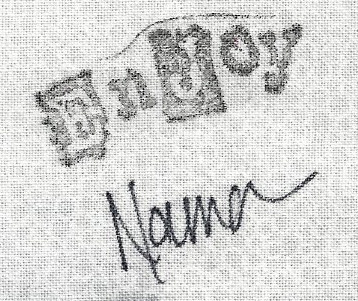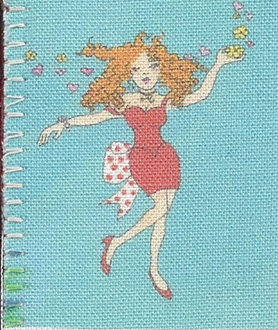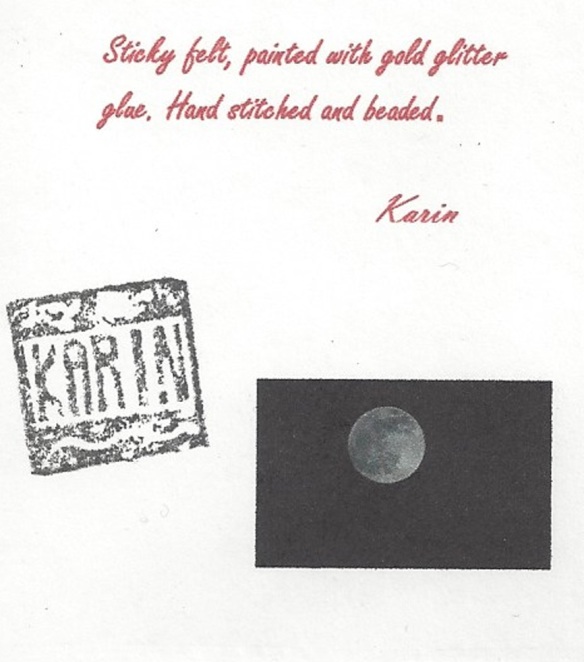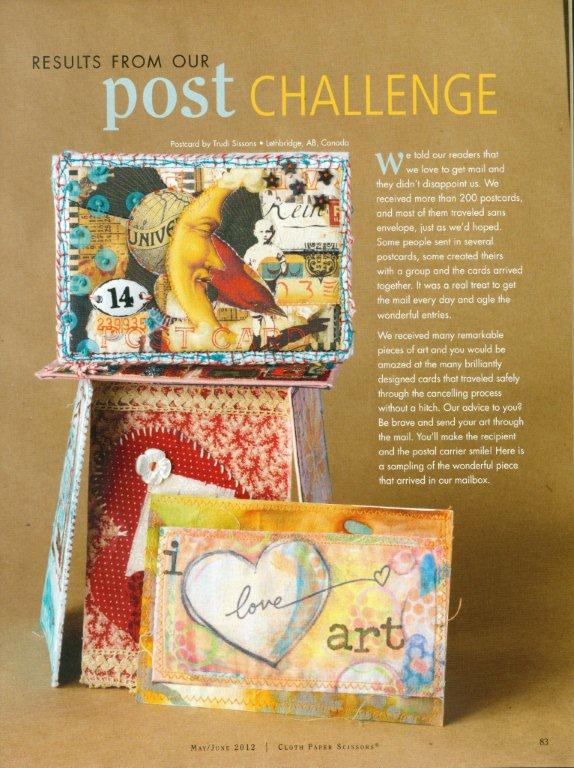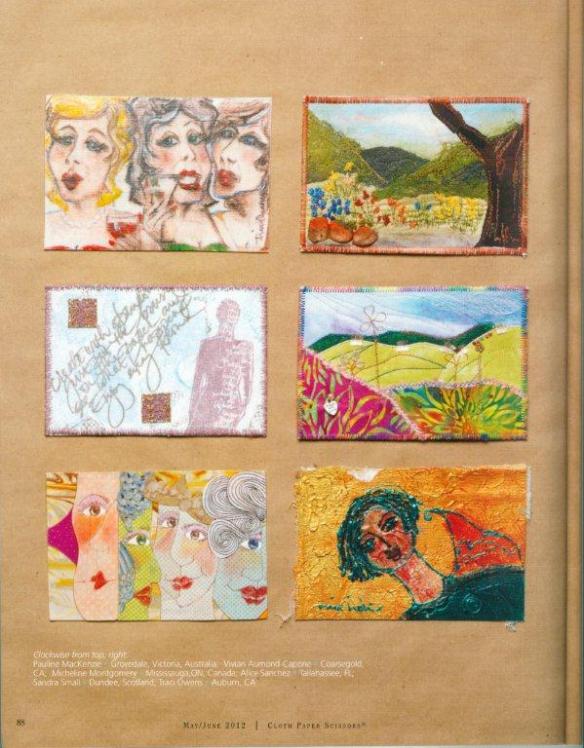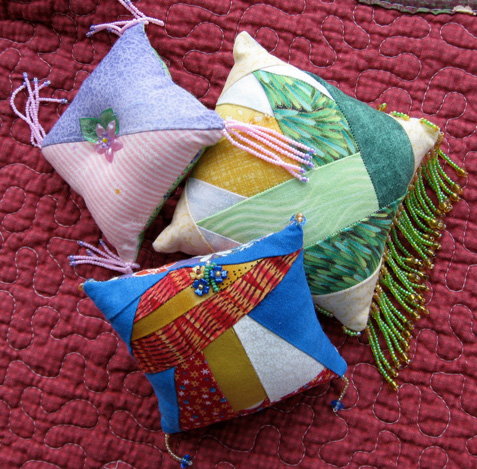This month we travel to Maysville, Kentucky to visit with Diana Mains Welte.
Do you call it a studio or sewing room? To yourself, to friends and family? Why do you think this is so? Difference in starting point between quilting and art? Thinking of this as a business rather than a hobby?
I call it my studio. I have always steadfastly had a studio in my home, since day one back in college. It’s been a corner, a table, a wall, a room, an outside workspace, a rented workspace, a huge room in my house, and again a wall. But I’ve always been an artist of some kind and I think artists need studios. It was important to me to have a dedicated space so art didn’t get lost in my busy days. That it was, in and of itself, valuable. By having a studio, my children respected it as my work and I was more productive.
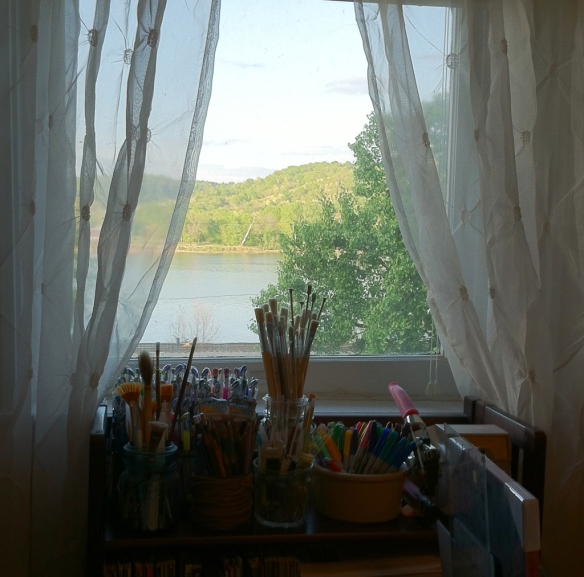
My studio is on the third floor of a historic apartment building in Maysville, Kentucky overlooking the Ohio River. I can see Ohio from my house.
What do you have in the room? machines, supplies, fabrics, paints, etc. Anything that might surprise the rest of us?
Definitely not as much as I did when I lived in our house – 13 rooms with the entire front room my studio. I was sewing clothing then and had clients coming in the home for fittings, etc. Then we moved to our apartment, and I stopped sewing clothing. And had to downsize. What a task! I gave away, sewed things to gift and sell, used it up. It took a while. Now I am down to one room, my wall studio, and creative storage. I own seven sewing machines – 2 Bernina 1080’s (what a workhorse), 2 Featherweights, another Singer, a Necchi and my grandmother’s Remington treadle. They come out from under the desk and table as needed. Fabric, paints, paperclay, beads, paper.

The wall – this is it. The complete studio. Shelves, worktable, fabric table and short bookshelf. And my white chair that I rescued almost 20 years ago from someone’s garbage.
How is your “stuff” organized? How do you organize your fabric? By color? Amount? Any separate categories (batiks, hand dyes)? How do you organize your thread (color, weight)?
Art supplies are in the cupboard above the worktable and on the top of the bookcase in front of the window. You can see the bookshelves (the one on the top is from the mail car of an old train.) That holds paper art supplies. The boxes on top – including the cigar boxes – hold wire and beads for jewelry making. And the fabric lives in the large white cabinet to the right of the workspace. Yarn is in a tub under the worktable.

My bookshelf holds favorite books and magazines and my collection of brushes, markers, pencils and other notions.

My other set of shelves. Both came from second hand stores.The lower shelves hold my subscription magazines and saved book covers from battered books.The upper unit is from the mail car from an old train. It holds a multitude of supplies: blocks of Creative PaperClay, eraser material for stamp carving, my dremel tool, my crop-a-dile, paint sets, paper punches, etc. The boxes on top hold beads, wire, and grommets.
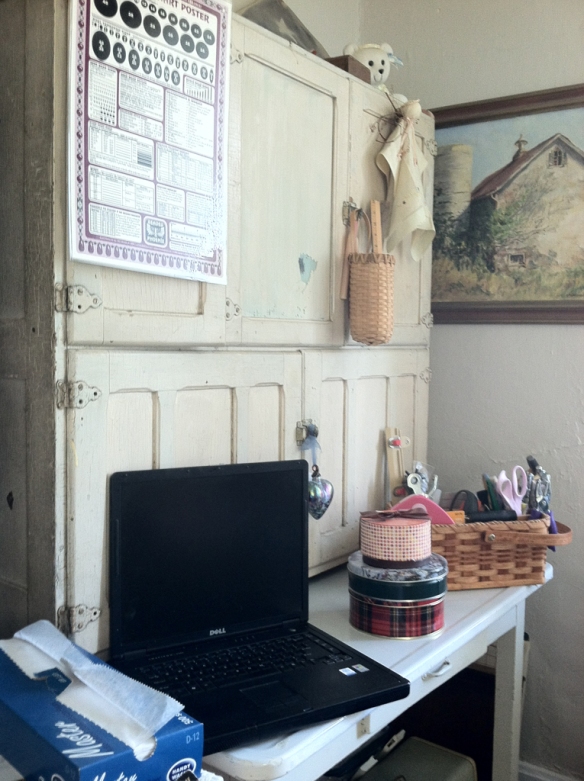 The antique cabinet that sits on a granite top kitchen table is where the fabric lives.
The antique cabinet that sits on a granite top kitchen table is where the fabric lives.
 The fabric cabinet and my button boxes.
The fabric cabinet and my button boxes.
Do you have anything, supplies, more machines, etc. tucked away in any other rooms of the house. How many other rooms? (My husband likes to talk about that one.) Has a family member or significant other ever accused you of “taking over” the entire house? If you have a separate building, we want lots of pictures.
We have one small room that used to be organized but, after our son Noah came to stay during his judicial attorney job with our local court, well, let’s just say it’s on our to-do list, so we can find everything we know we own that is missing. LOL. For me, it houses plastic tubs of wool, yarn and old linen, as well as odds and ends. For Noah… who knows? When baseball season ends (Noah coaches), we shall tackle that job.

AAAACK! The dreaded storage room. Soon to be rearranged. I do know what everything is though and that is a major accomplishment in itself.
I work on things as I watch tv but, afterward, the projects have to go into the studio. I keep a basket by my chair and clear off the rest as much as possible. My ottoman does overflow sometimes, but I sort that all out and move it back into the studio on a regular basis. Honestly, we live IN the studio. The wall is in my bedroom, the bookcases in the living room. Joe’s office is in the second bedroom as he works from home too. Noah’s room is the former dining room. But it is all incorporated into our home so it’s not too noticeable. Right now we’re a family of 4 living in a small space (3 humans and the cat who allows us to live here), so we aren’t too concerned about the décor… more about artful storage.

My comfy knitting chair, another thrift store find. The items on the marble top dresser behind, like my grandmother’s dresser set, and the gifts from my children are priceless. The sewing machine is my grandmother’s old treadle. The stained glass window was the transom window from my paternal grandparents’ home; it was over the front door.
 Living room bookcases. The basket was made by my daughter when she was young.
Living room bookcases. The basket was made by my daughter when she was young.
How much horizontal surface do you have, and is it ever enough? Do you have to move piles of stuff to cut anything bigger than a fat quarter?
Just the work table and a folding table that comes out if I ever need to sew large things. But I don’t use it much anymore as my art, artist books and jewelry are small work. So the work table is all I need. When I paint, I use a dropcloth on the floor and cover the table. And, no.. it’s not enough. 🙂
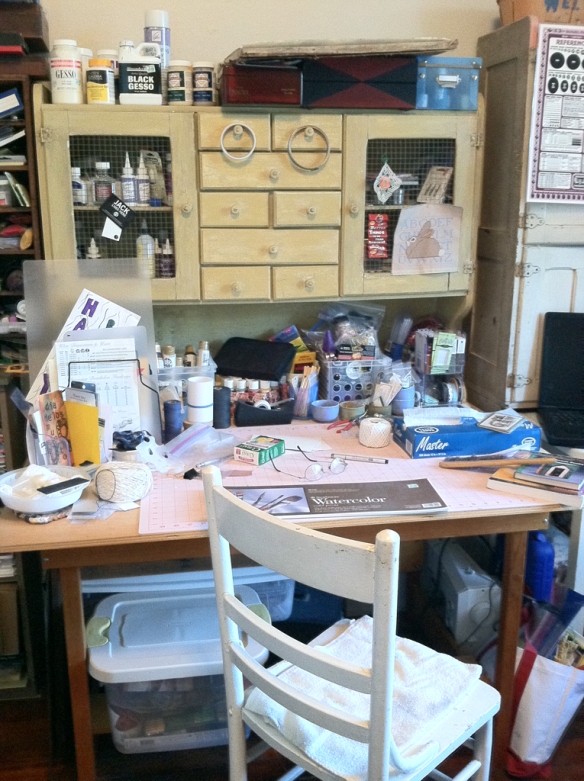
My worktable used to be drafting table height. It was a gift from my dad and my sisters.The first family birthday gift the year after my mom passed in 1979. I wouldn’t part with it for anything. The topper is a mustard color topper to a Hoosier cabinet that I found at a second hand shop. It fits the table top like it was custom made. The drawers hold special markers like my expensive Copics, buttons, soldering supplies, vintage trims, and other odds and ends. Behind the wire covered doors are glue, resin, thread boxes, and cutting tools.The boxes on top hold polymer clay tools, sterling wire and findings and, in the blue box top right, my beloved Dr.Martin Inks and nib pens. Underneath is one Featherweight and one of my Berninas, and the tubs that hold the current quilts in progress and sock yarn.
Do you straighten/organize as you go, putting each fabric away as you cut, or do you clean up after a project? How many projects do you work on at a time and how do you keep them organized?
I do put things away as I go. I didn’t used to, but now have to be better about that. I am the queen of plastic bags… should buy stock in those companies. I have work in progress in the gallon size bags and they live in totes, stored with their instructions and supplies. That also helps when I travel as I can grab whichever bag I want and add any needed supplies.
Anything more you want to add about your studio, organization, working methods, etc., please do.
I was honestly a bit sad when I had to give up my previously large room, but now 2 years in, I get more accomplished with my smaller space. My family gifted me with polymer clay supplies at Christmas and I just bought a small kiln for ceramics. We plan to move to the greater Cincinnati area within the year – after Noah moves into a more permanent law job. I will definitely be looking for a place with room for my clay work.
 My assistant, babykitty, at work. She’s the brains behind the business.
My assistant, babykitty, at work. She’s the brains behind the business.
Thank you Diana for a delightful tour. You have certainly provided lots of ideas for the creative use of space.
Visit Diana’s blog, Lilyweeds.
Next Month: Karen Musgrave

